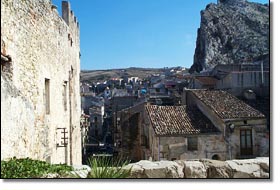 |

The actual village called Marineo (30 Kms far from Palermo), is situated on a hillock surmounted by a big rock, “LA ROCCA”, called by poets “canine tooth of Sicily” or “Polyphemus’s tomb.
Since XVcentury, it wasthe Great Hospital of Palermo who owned this feud.
In 1549,Nicola di Amari, who held the feud in emphyteusis, gave it to Francesco Beccadelli Bologna. This nobleman received a “licentia populandi” (a license to found a new village), by the Emperor Charles the castle, the Cross Church and the Cathedral to be built.
On the hillock called “La Montagnola”, for a very long period before the birth of the actual village, an important civilisation had place. The hill, 623 metres high on the sea, overlooks Eleuterio River.
It had a comfortable slope to Northeast, steep impregnable faces and a unique simple entering way.
Some rare fragments of pottery found there date back to VIII century b.C.. During the centuries, the city got richness and importance for its link position between the hinterland and the coastline, on the road linking Palermo with the country.
It was a native centre, influenced by Punic and Greek domination. After Roman conquest, it began declining and at the end disappeared before Arabian conquest.
Arabian people lived in this place, and then also the Norman people occupied the hill. In the middle of XIV century, because of the fights between Latin and Catalan armies in Sicily, the site was deserted and the city disappeared forever.
|
 |
correlative
themes:
 art and monuments index art and monuments index
legenda:
red arrow shows an
active link to a new page
gray arrow refers to the page you're visualizing or
an inactive link
|